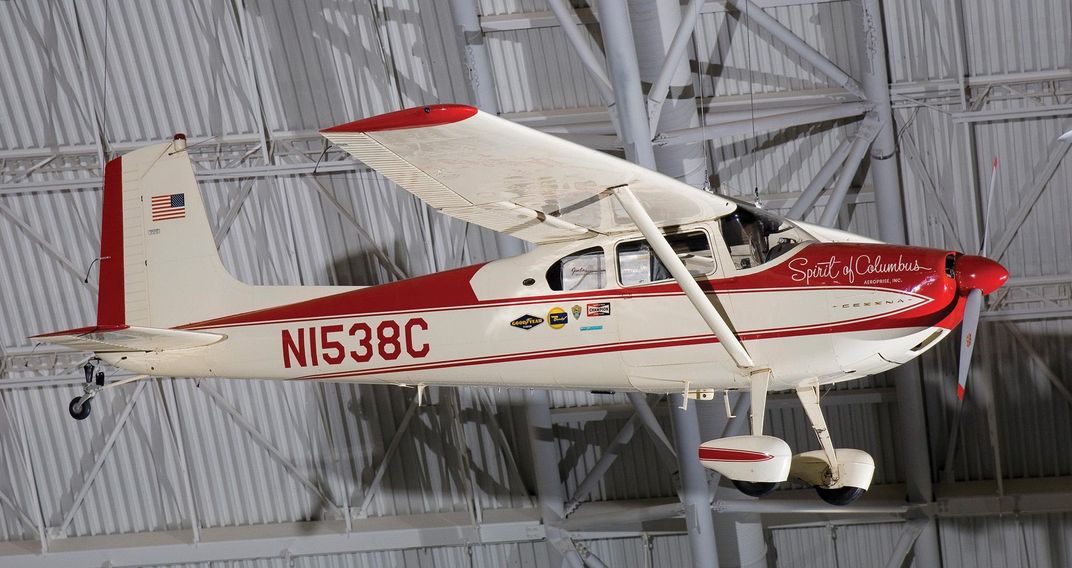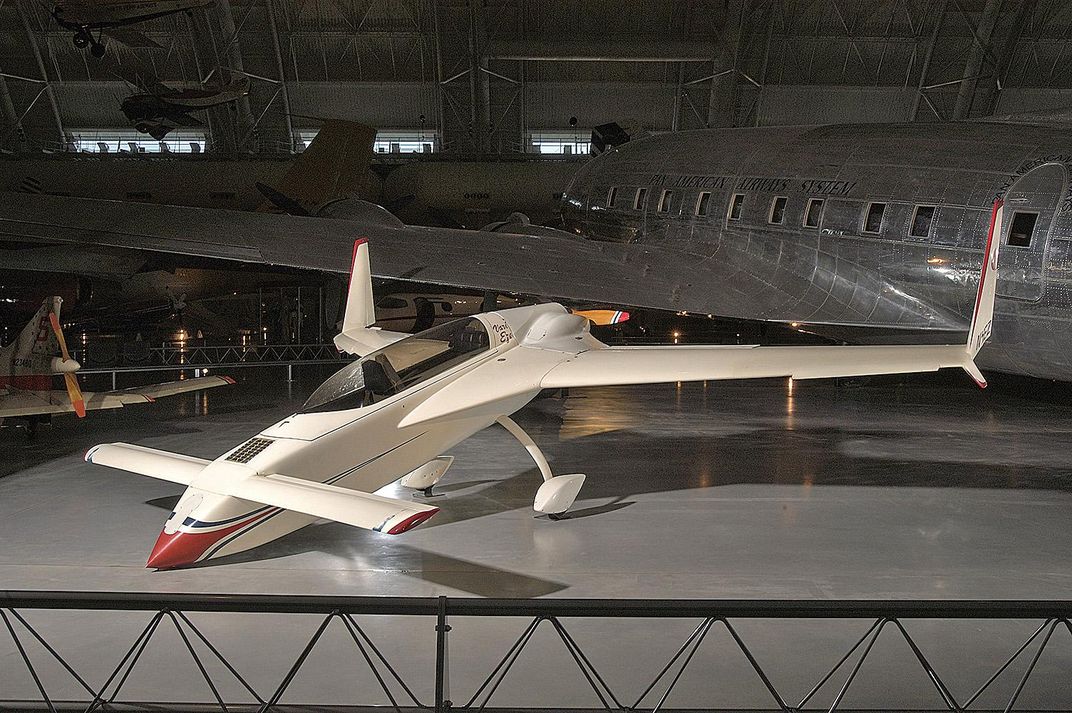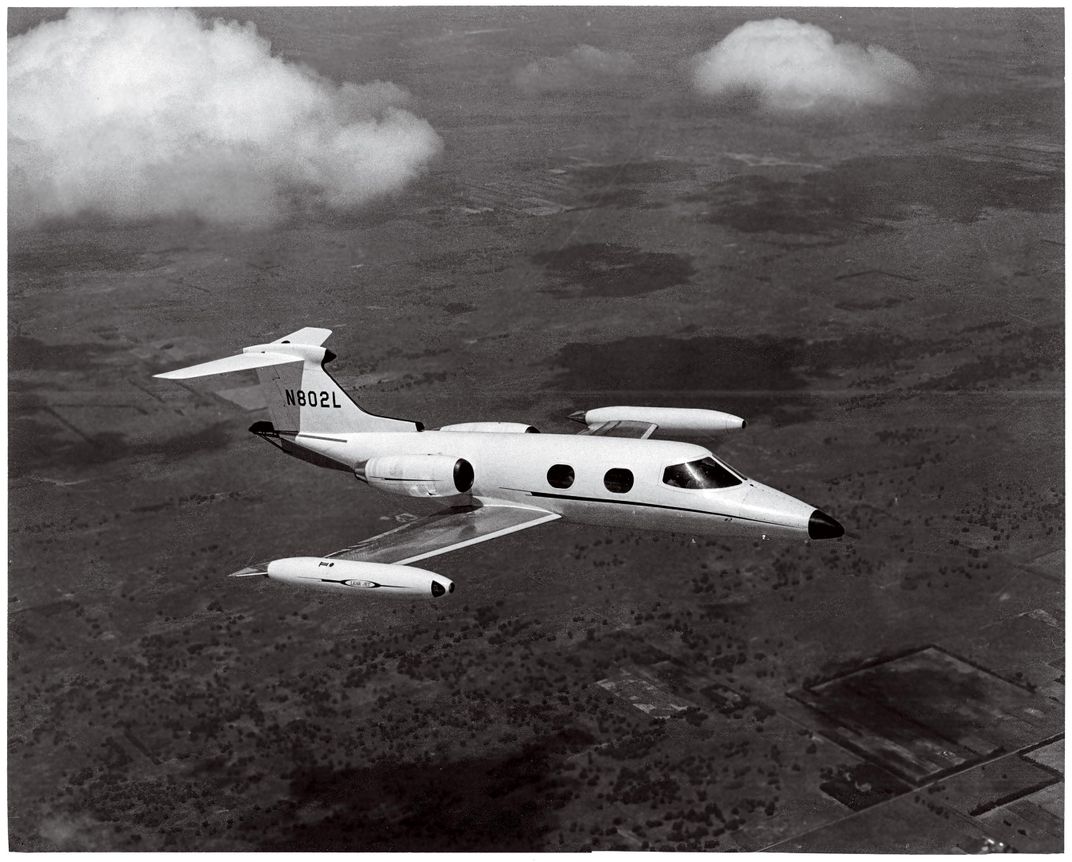A New Gallery Celebrates the Variety That Is General Aviation
From private pilots to aerobatic racers.
:focal(1366x1028:1367x1029)/https://tf-cmsv2-smithsonianmag-media.s3.amazonaws.com/filer/0a/a1/0aa111cc-e1e1-453b-8d7e-7feab50f12d4/15k_as2021_weallflygallerypreview-waf_entranceviewrevised2_live_copy.jpg)
On April 17, 1964 at 9:36 p.m., Jerrie Mock landed a Cessna 180 at Port Columbus airport in Ohio and became the first woman to fly around the world. It had been more than 29 days since she had taken off from that spot for a 23,103-mile journey—and more than 27 years since she had been inspired to do it by Amelia Earhart’s attempt. Today the modest, single-engine, four-seat Cessna she flew, the Spirit of Columbus, is headed to a new gallery in the Smithsonian’s National Air and Space Museum devoted to the largest category of human activity in the air—general aviation. Scheduled to open in 2022, the Thomas W. Haas We All Fly gallery will help define the wide world of general aviation and, through interactive exhibits and audiovisual displays, explore its impact on everyday life and how it has influenced society.

Most people experience flight aboard airliners, and a great many have flown in military aircraft. General aviation is everything else—private pilots who fly for fun and those who, like Mock, set records; performers who fly aerobatics and compete in races; and professional pilots who fly for all kinds of practical reasons other than fighting wars or moving cargo and hundreds of passengers at once. Business transports, firefighting platforms, and airplanes flown on search-and-rescue and other humanitarian missions are all part of the general aviation scene. The new gallery will organize them according to five themes: private, sport, business, humanitarian, and utility flight.
The Cessna 180 that Mock flew around the world anchors the theme of private flight. It represents not only her historic achievement but the broad appeal of private aviation in the 1950s and ’60s, when Cessna, along with Beech and Piper, worked hard to make airplanes affordable and easy to fly. Cessna built 6,000 180s and 22,000 of its tricycle-gear cousin, the 182. In 1960, the 180 taildragger got a more powerful engine and a new name, the Skywagon, emphasizing its suitability for getting a family of four from here to there. Although the post-World War II boom in private aviation was short-lived—in the United States, there were 81,000 private airplanes flying in 1946, but by 1949, only 3,500 additional aircraft were sold—piloting an airplane became accessible to tens of thousands of people.

By the beginning of the 21st century, private pilots were eager for new sophisticated designs, and the gallery includes the answer to their call—the Cirrus SR-22. Debuting in 2003 with a glass cockpit and whole-airframe parachute, it was the first clean-sheet design in 50 years.
In the private-pilot section of the gallery, exhibits explore how general aviation was also a flight path for social change. Before World War II, people of color and women were barred from military and commercial aviation, but they found ways to fly anyway, by setting records, networking, and forming clubs. Many women and Black pilots made their own opportunities: Bessie Coleman, the nation’s first Native American and first Black woman pilot, performed at airshows in the 1920s. Amelia Earhart became famous by crossing oceans and setting records. And Dale White, with Chauncey Spencer, flew from Chicago to Washington, D.C. to prove that Black Americans could fly and should be admitted to military flight training programs. Although full integration in aviation did not come until the 1970s, these pilots blazed a trail for others to follow.
Many companies purchased Cessna 180s to fly on corporate trips, but by the time Mock flew around the world, executives wanted jets. From the ceiling of the business-theme section of the gallery hangs the most famous bizjet in history. Conceived and branded by William “Bill” Lear, the fast, sexy Learjet 23 appealed to executives and became a cultural icon. Made a symbol of the high-rolling good life by Frank Sinatra and other celebrities, it has had cameos in TV, film, and rock songs.
The sport-aviation section showcases another kind of celebrity—the extraordinarily talented pilots who perform aerobatic routines at airshows. The Challenger III in which Sean D. Tucker entertained millions is on display here. The section also shows the many ways people who aren’t pilots can enjoy aviation, whether by attending airshows, taking a hot air balloon ride, or hang gliding. The centerpiece of the sport-aviation area is a typical homebuilder’s workshop, where visitors will find the kit developed by Burt Rutan for his popular VariEze, the high-performance, composite two-seater that revolutionized homebuilding. Here, visitors can also watch a how-to-build-your-own-airplane video.
The humanitarian and utility flight sections focus on the public benefits of general aviation. From aerial firefighting and medical and rescue services to maintaining the nation’s food supply through modern cropdusting, these activities have enormous importance in everyday life. Some of the organizations reflected in the gallery include LightHawk, which, with a network of 300 volunteer pilots, flies conservation missions and wildlife surveys; the Orbis Flying Eye Hospital, which for 40 years has been training eye care professionals around the world; the Fairfax County, Virginia Police Department, which uses aircraft for law enforcement as well as for medevac missions; and travel bureaus in Hawaii that conduct aerial sightseeing tours.
Still not clear about all the many activities included in general aviation? With the “What is General Aviation?” interactive database, you can select an airplane and learn the type of mission it flies. Once you’ve seen what general aviation entails, you might decide you’d like to work in the field. “Entry Points” is for anyone wondering what kinds of jobs exist. You don’t have to be a pilot—you can choose from among more than 20 other careers or opportunities.
In fact, that’s one of the messages of the new gallery: that general aviation is still very much a thriving field. The United States has more general aviation pilots, aircraft, and airports than any other nation in the world. About 5,200 of the 19,000 total U.S. landing fields are public airports. Commercial airlines, by comparison, fly to only 560 airports, and three-fourths of their flights go to just 30 hubs.
More than 13,000 airports are privately owned. Remote communities in Alaska and around the world rely upon small airports to get the goods and services they need. Airports can serve as economic gateways for their communities. Flabob Airport in California, which opened in 1925 and nearly closed only a decade ago, is a model for reinventing an airport as a community asset. Local airports are often centers for aeronautical recreation, education, and training opportunities.
Starting next year, a good place to begin learning about general aviation is the Thomas W. Haas We All Fly gallery, where Museum guests will find not just airplanes but aviation-related art: photo-realistic prints, glass sculptures, and the photographs of Jeffrey Milstein, who snaps portraits of airplanes just as they’re about to land. Display cases round out the story with model airplane kits, a pedal plane, and flight gear. There’s even a “flying” lawn chair.
From drones to jets, in this gallery it becomes very clear: We All Fly.
Dorothy Cochrane is the curator of general aviation at the National Air and Space Museum. She is the lead curator for the new Thomas W. Haas We All Fly gallery.
/https://tf-cmsv2-smithsonianmag-media.s3.amazonaws.com/filer/f0/8c/f08c9375-7a3b-4f8a-9f7f-5bdd66bd53cd/15i_as2021_weallflygallerypreview-replacese_waf-ff_live.jpg)
